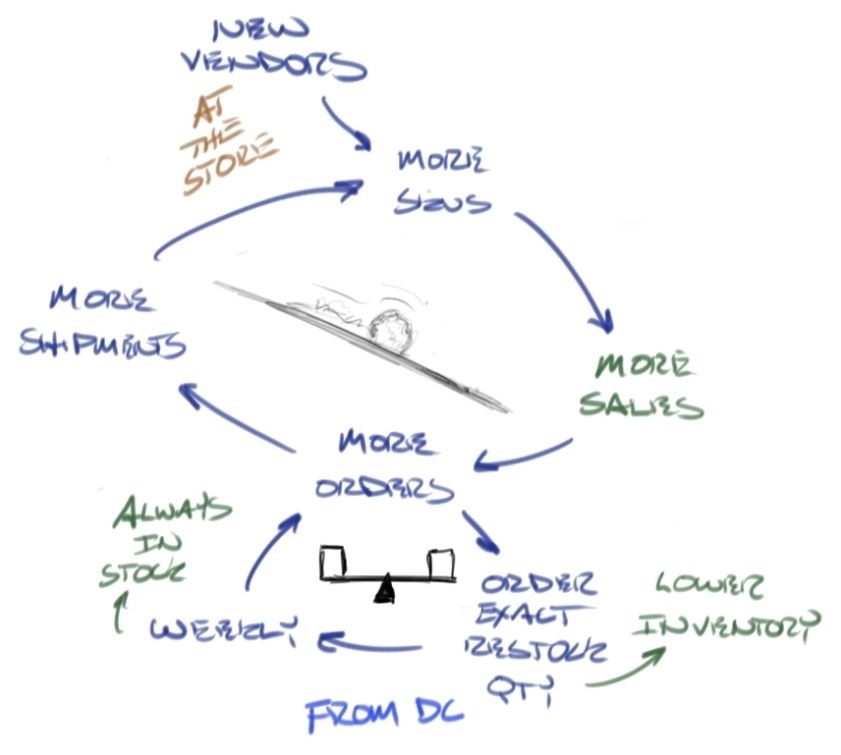Receiving Part 8
The tool department was astounding. I remembered having visited this store about six months earlier, before the new tool program rolled out. It was remarkable. The display of hand tools, power tools, and accessories was a little overwhelming — there was so much. What I did not see was empty peghooks. Every spot had something hanging, and every shelf was filled.
Another thing I did not see was an employee, or the manager. I walked the aisles for a few minutes looking at the merchandise, looking at the depth of stock, and I started to notice something. The items that we supplied from the distribution center only had a few units per SKU, while the slots for the items that had to come direct from the vendors held more units. I started to notice power tools lines we did not carry in the DC, and the matching accessories. It looked like each accessory location could hold at least six units, perhaps as many as eight. The same with the power tools: each shelf could hold about five units, if not more.
“Jackie told me you came over here,” said a voice. I looked up to see the tool department manager walking down the aisle. “I’m Steve, the Tool Manager.”
“I wanted to see what the tool program looked like in the store,” I replied. “All we see are the cartons of power tools and the cases of the accessories. It’s good to see it all on display. I see that there is more here than what we ship to you. It that all vendor direct?”
“Yep,” he said. “The direct vendor lines, like these impact hammers, are the total category of product, the tools, the accessories, and the consumables. The propane torches are another category that comes direct. Air tools and fittings too.”

I had wondered what happened to the air tool fittings. We still carried the compressors and the hoses, but the fittings and tools disappeared from the DC as the new tools came in. The same thing happened to the torches; we never carried the fuel in the DC, but we had carried the torches.
“What do you think of the way we are picking and shipping your tools?” I asked. “What can we do to make it better?”
Steve looked around the area a little bit and then pointed out the drill bits. “We order these by the eaches, not in packs. You guys just put them between other cartons on the pallet, and they get lost as the pallet moves around. If you can pack them into a carton, that would help.”
“I wish we could ship them in packs,” I said. “They come in boxes of twelve, and that would cut down on the number of times you order them and we pick them. We pick them every order now, and shipping in the carton will save the effort in the DC.”
“I understand that,” he replied. “But we can only get six units on a peghook, and you shipping twelve units creates back stock we have to manage. These are about $9 each at cost, so you shipping by the dozen drives up our inventory.”
I looked around that area again and asked about his back stock.
“We don’t have any,” he said. “Not even on the vendor-direct stuff. All of the inventory is out here on the floor. If I am ordering right, we should not have any back stock.”
I thought about the aisle I had seen in the back stock area — no tools, but filled with paint items. “That’s right, I saw paint in the back stock area marked tools, but I did not see any tools.”
“The category managers at corporate told us to plan on eliminating the tool back-stock,” said Steve. “In fact, they told us to inventory any obsolete inventory, and then donate it to the Salvation Army. We had two pallets of old stuff that we no longer sold, so we donated it all.”
“What about the vendor-direct product lines?” I asked. “The Paint department is having a hard time with their reorders.”
Steve smiled. “All of that good-better-best stuff is in the DC. The direct vendors have entire categories, and the category is not split between vendors like the paint brushes. And the direct vendors have low minimums and short lead times.”
“How low and how short?” I asked.
“The typical minimum is $750, some are $500. The worst lead-time is two weeks, the rest are one week. Then there are the DC orders that are two days.”
Looking at my watch, I thanked Steve for his time. I needed to get back to the DC and follow up on the idea to pack the loose items into a box in picking.
The Difference
As I drove back to the DC, I thought about the difference between the Tool and Paint Departments. Clearly Steve had the better deal. Poor Jackie was stressed out over her inventory and the back stock. The receiving room manager had her arms full with the many direct shipments that rolled into her space.
Two different departments; each with different problems and different outcomes.
I wanted to figure out why.


